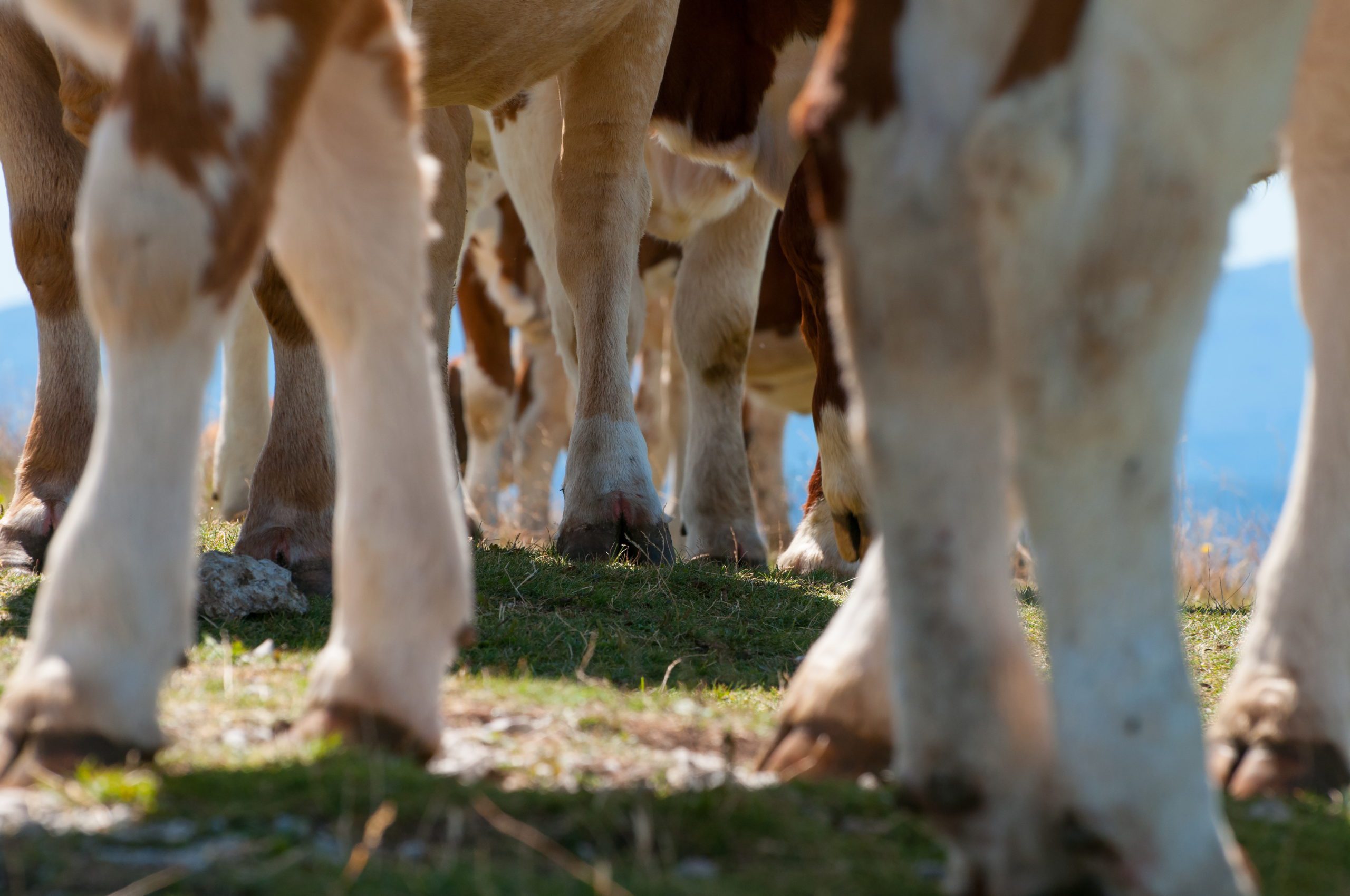|
Maintaining optimum herd health is one of the greatest challenges cattle producers face. Herd losses quickly lead to lost profit; the loss of young heifers, in particular, can mean missed breeding opportunities and fewer head to take to the sale barn. To put this into perspective, in 2015 the total estimated cost of death loss in cattle and calves was $3.87 billion. Blackleg is a fairly common disease in cattle and can have dire consequences. It can strike without warning, it has a high mortality rate, and its symptoms are not always easy to detect. Fortunately, producers and feedlot operators can take steps to increase the immunity of their herds and reduce the chances that their animals will contract blackleg. What Is Blackleg?Blackleg is a clostridial disease that primarily affects young cattle raised on pasture. A clostridial disease is one caused by anaerobic bacteria in the soil. These bacteria have protective coverings known as spores and are often fatal to the animals they infect. More than 60 types of clostridial bacteria exist, though not all of them have the potential to cause disease. Black disease, malignant edema, tetanus and botulism are examples of other serious clostridial diseases. Blackleg is primarily caused by the clostridial bacterium known as Clostridium chauvoei. Its spores are incredibly widespread — they are found virtually everywhere in the environment. The disease is also known as clostridial myositis. C. chauvoei was discovered in 1887 and later took its name from a French veterinarian, J.B.A. Chauveau. It is a gram-positive, spore-forming rod that is found in soil and the feces and digestive systems of many animals, such as cattle. The spores are highly resistant to harsh environmental conditions and many disinfecting agents. They can be found in pairs and sometimes in small chains, but most often each single bacterium exists in isolation, though there may be many other bacteria in the surrounding earth. How Do Cattle Contract Blackleg?Cattle often consume blackleg spores as they graze at pasture. When cattle consume low-growing vegetation, they may ingest some soil — and spores — as well. The spores then travel through the digestive system, pass through the intestinal wall, move through the cow’s bloodstream and disperse throughout the muscle tissue in the animal’s body, where they may remain dormant for some time. The spores often end up in the musculature of an animal’s legs, especially the hind legs, though they can also infect areas such as the tongue, diaphragm, udder or brisket. Experts are unsure why the spores so often colonize muscle tissue in preference to other types. Lack of oxygen to the muscle tissues can cause the spores to emerge from their dormancy. When the spores become active, they proliferate rapidly and cause gas gangrene in the muscles, which quickly leads to the characteristic dark-colored lesions that give the disease its name. Tissue necrosis and toxemia generally result, as well. Though blackleg does not always cause outward discoloration, cutting into a diseased animal’s infected leg will reveal areas of darkened tissue where gas gangrene has formed. If superficial muscles are involved, a darkening of the observable tissue of the affected legs is also common. Active blackleg infections ultimately prove fatal in a majority of cases. Many necropsies reveal inflammation in the hearts of cattle that have died from blackleg, particularly fibrinous pericarditis and necrotizing myocarditis, in addition to lesions and necrosis in their skeletal muscles. It’s important to note that although blackleg is infectious, it is not contagious from individual to individual. So an infected animal cannot spread the disease directly to other members of the herd. It is also not necessary for cattle to have open wounds to contract blackleg — consumption and subsequent bruising and injury are sufficient to activate the disease. Blackleg in CalvesBlackleg in calves is a particular concern. Blackleg has been observed in calves as young as six weeks. However, most blackleg cases occur in calves and cows aged six months to two years. Even strong calves who appear to be in robust condition and are growing rapidly are susceptible to this disease — in fact, young calves growing rapidly are among those most likely to be infected. Adult cattle can contract blackleg as well, but infections in adults are much less common, though they can occur, especially in elderly animals. Causes of Blackleg Disease in CowsA number of different environmental factors increase the likelihood that cattle will contract blackleg disease:
What Are the Symptoms of Blackleg in Cattle?Blackleg symptoms in cattle are often difficult to spot. Because the disease progresses so rapidly, in many cases, calves quickly become ill and die before symptoms have become apparent, often within 12 to 48 hours of contracting the active disease. However, some symptoms of blackleg may become evident, and it’s essential to keep a watchful eye out for them:
In some cases of blackleg that lead to congestive heart failure, symptoms such as a distended jugular vein and edema of the brisket have been reported. However, these reports are rare. Although veterinarians may make a presumptive diagnosis of blackleg on the basis of the above signs and the animal’s clinical history, the official diagnosis requires the detection and isolation of C. chauvoei in the affected tissues. How Do You Treat Blackleg in Cattle?Typically, treatment is ineffective against blackleg, and the mortality rate of the disease is relatively high. In some cases, if the disease is detected early enough, penicillin can be effective in saving an animal’s life. A cow that survives blackleg, however, usually suffers from a permanent deformity or lameness. For this reason, and because eliminating blackleg spores from the environment is virtually impossible, one of the best treatments for blackleg in cattle is vaccines. Blackleg VaccinesVaccines cannot treat blackleg in an afflicted cow, but they can help to prevent healthy cows from contracting the disease. The standard recommendation is to vaccinate calves once they reach two to three months of age, and the again around 6 – 8 months, the time when they start to wean. Until then, the antibodies they received via their mothers’ rich colostrum shortly after birth should protect them. When the calves reach weaning age, a vaccination protocol becomes critical. Typically, calves should receive two doses of vaccine during this time, with the second dose following three to six weeks after the first. Because all blackleg vaccines are killed or inactivated vaccines rather than live vaccines, the second shot is often essential to ensure the vaccine’s effectiveness. Annual or semiannual boosters are recommended afterward until the animal reaches two years of age. Vaccinations should take place before the danger of blackleg becomes high — usually spring or early summer. The available vaccines are typically extremely effective against blackleg — the limited research on the subject suggests these vaccines are nearly 100 percent effective against blackleg contracted from the environment. The antibodies the vaccines stimulate minimize the toxic effect of any spores that become active within an animal’s body. These vaccines usually protect against several other diseases as well, including malignant edema, black disease and enterotoxemia. What Other Animals Can Get Blackleg?Blackleg-like conditions have been described in other species, particularly sheep and goats. Sheep are known to contract blackleg infections, but these animals often become infected through open wounds rather than by ingesting the spores. Infections in sheep typically occur after some form of acute injury, including cuts from shearing, docking or castration. It is possible that those cases are merely gangrene associated with C. chauvoei, rather than true blackleg. C. chauvoei infections similar to blackleg have also been reported in animals such as deer, horses, pigs, oryx, elephants and even whales. |





